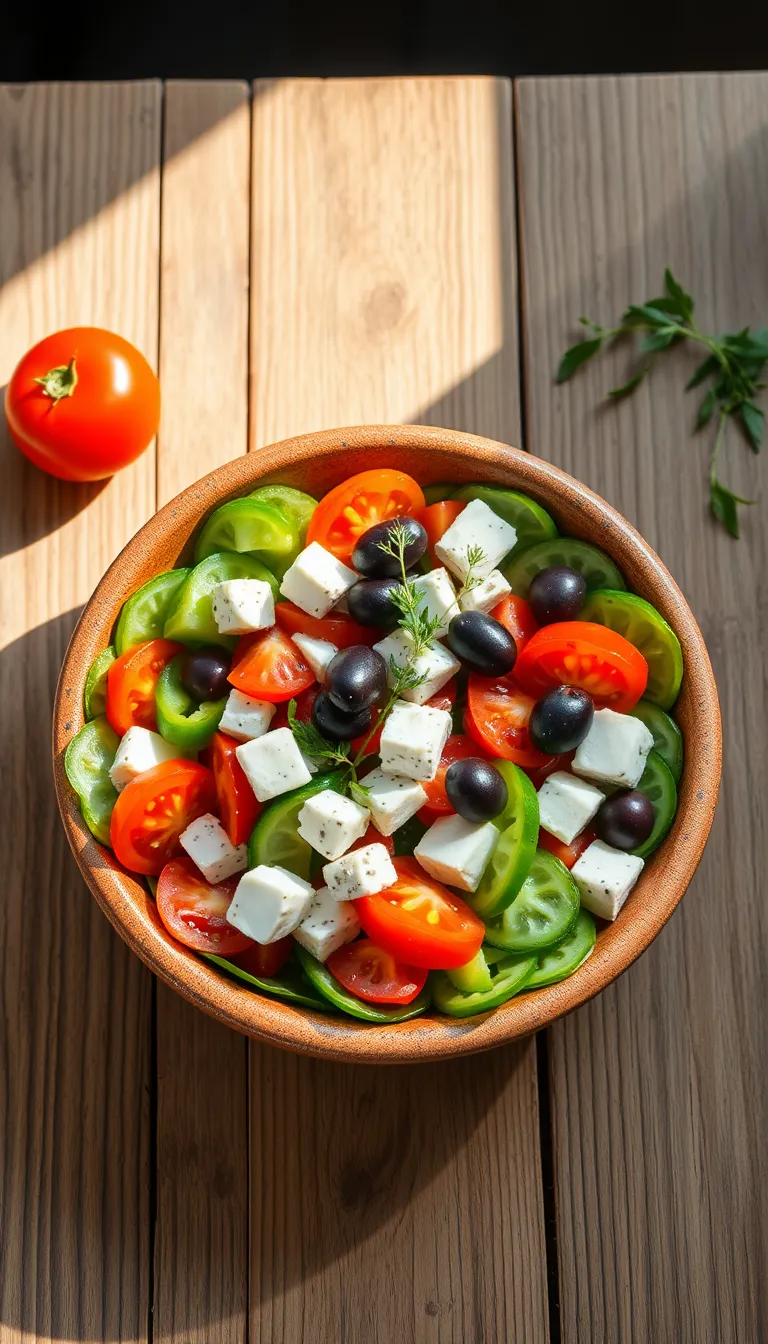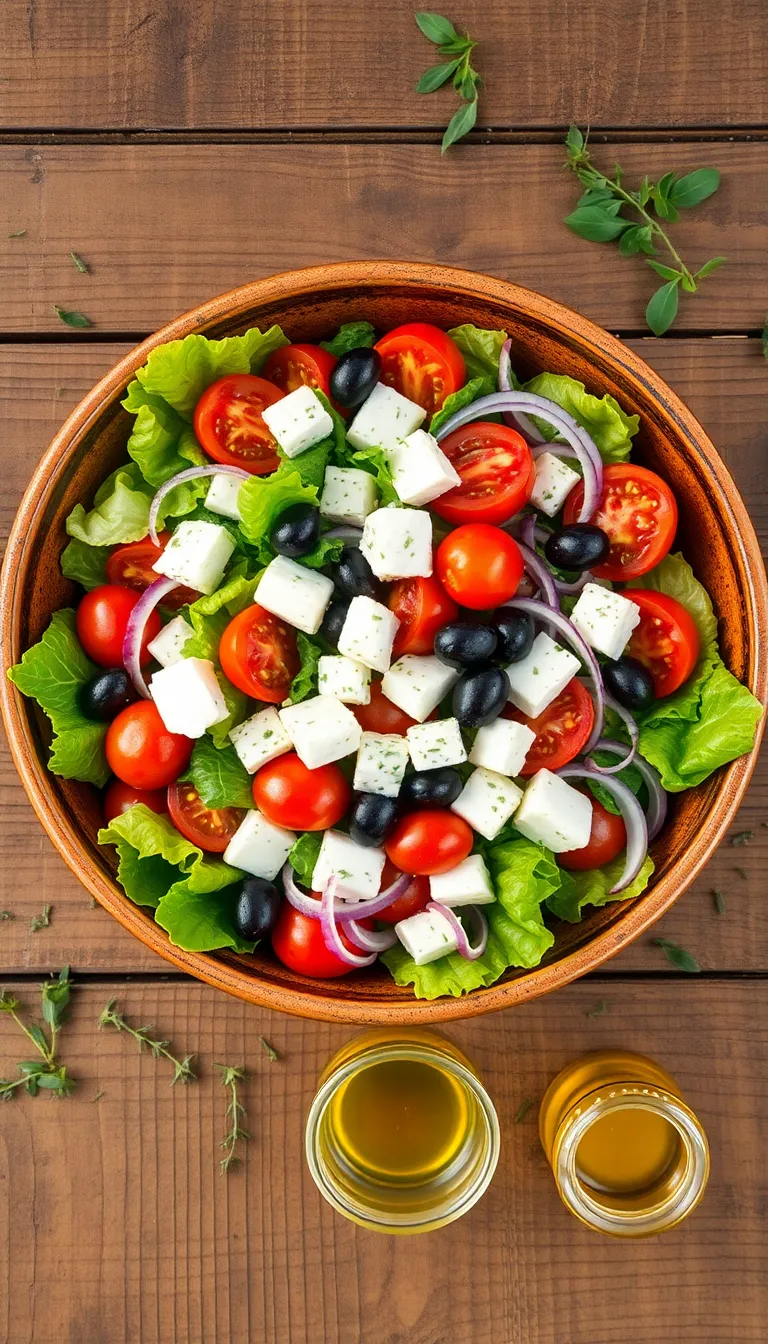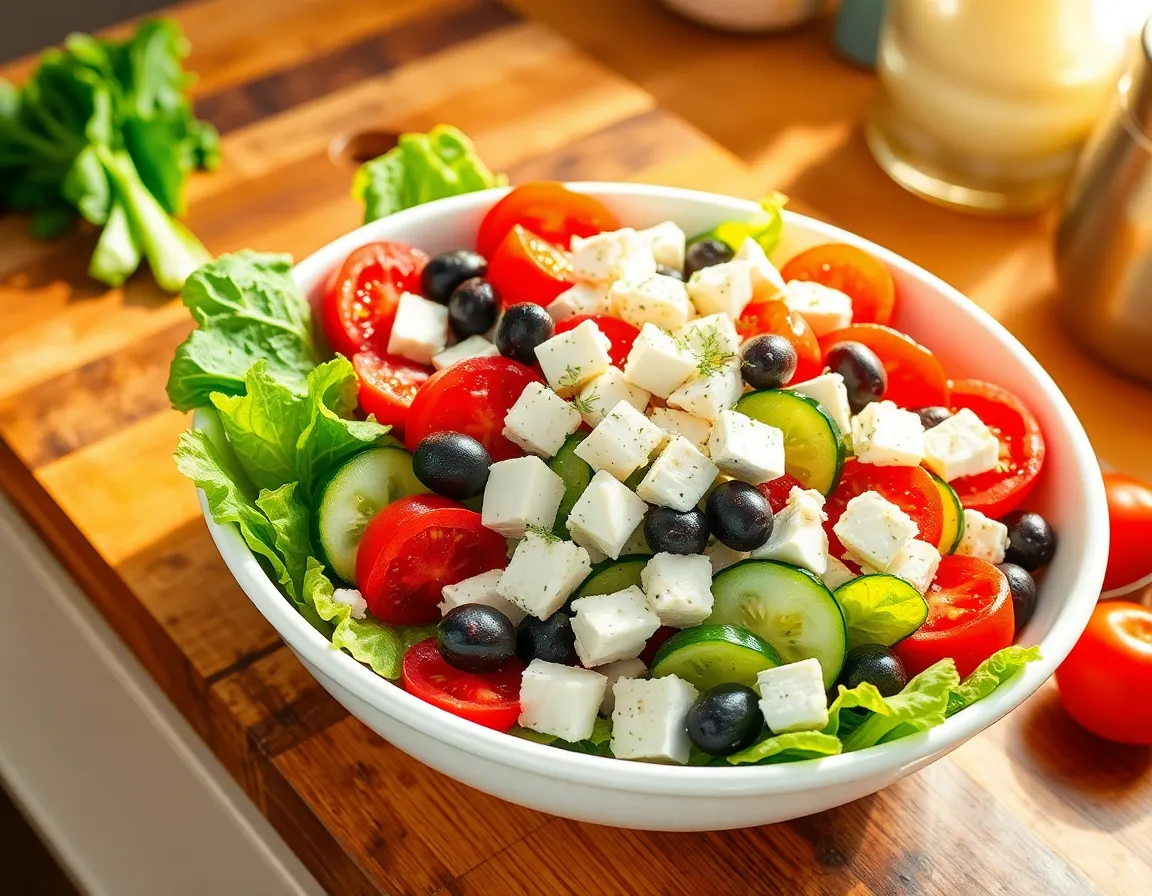Get ready to transport your taste buds to the sun-drenched shores of the Mediterranean with this classic Greek Salad recipe! Whether you’re a novice in the kitchen or a seasoned chef, this dish is bursting with the vibrant flavors of crisp cucumbers, juicy tomatoes, and tangy feta cheese, all brought together by a drizzle of rich olive oil and a sprinkle of oregano. It’s a sensory delight that captures the essence of Greek cuisine, perfect for any occasion.
Imagine the satisfying crunch and the refreshing coolness of fresh vegetables mingling with the briny goodness of Kalamata olives. This salad is not just a side dish but a celebration of simple, quality ingredients that come together effortlessly. No matter your level of expertise, you’ll find joy in crafting this delightful dish and confidence in serving up a taste of Greece right in your own home.
About This greek salad Recipe

- Authentic Flavors: This Greek Salad recipe captures the vibrant and fresh tastes of the Mediterranean with its use of ripe tomatoes, crisp cucumbers, and tangy feta cheese.
- Quick and Easy: With just a few simple steps and no cooking required, this dish is perfect for a quick lunch or a no-fuss dinner side.
- Healthy and Nutritious: Packed with fresh vegetables and olive oil, this salad is a great source of vitamins, minerals, and healthy fats.
- Customizable: Easily adapt the recipe to suit your preferences by adding olives, bell peppers, or even grilled chicken for extra protein.
- Perfect for Any Occasion: Whether you’re hosting a summer barbecue or preparing a light meal, this salad is a refreshing addition to any table.
Why You’ll Love This Recipe

- Authentic Flavor: This Greek Salad recipe captures the true essence of Mediterranean cuisine with its fresh and vibrant ingredients.
- Quick and Easy: Ready in just 15 minutes, it’s the perfect dish for a busy weeknight or a spontaneous get-together.
- Nutritious and Healthy: Packed with vitamins and antioxidants from fresh vegetables and healthy fats from olive oil, it’s as good for you as it is delicious.
- Versatile Dish: Enjoy it as a light lunch, a side dish, or pair it with grilled meats or fish for a complete meal.
- Customizable Ingredients: Easily adapt this recipe to your taste by adding or substituting your favorite veggies or proteins.
Ingredients
Ingredients
- 3 cups chopped Romaine lettuce
- 1 cup cucumber, sliced into half-moons
- 1 cup cherry tomatoes, halved
- 1/2 cup sliced red onion
(For a milder taste, soak in cold water for 10 minutes before using)
- 1/2 cup pitted Kalamata olives
- 1/2 cup green bell pepper, sliced
- 1/2 cup crumbled feta cheese
- 2 tablespoons extra-virgin olive oil
- 1 tablespoon red wine vinegar
- 1 teaspoon dried oregano
(Fresh oregano can be used as a substitute; adjust to taste)
- 1/4 teaspoon salt
- 1/4 teaspoon black pepper
- 1/4 teaspoon dried thyme (optional)
- 1 clove garlic, minced (optional)
Kitchen Tools You’ll Need
- Cutting Board: Essential for chopping vegetables like cucumbers, tomatoes, and onions. A large, stable board will make the process easier and safer.
- Chef’s Knife: A sharp knife is crucial for efficiently cutting through the vegetables and herbs needed in the salad. Ensure your knife is well-maintained for best results.
- Mixing Bowl: A large bowl is necessary for combining all the salad ingredients and tossing them together. If you don’t have a mixing bowl, a large pot can be used as an alternative.
- Salad Spinner: Useful for drying lettuce or any leafy greens after washing. If you don’t have a salad spinner, you can pat the greens dry with a clean kitchen towel.
- Whisk: Needed for emulsifying the salad dressing ingredients. If you don’t have a whisk, a fork can serve as an adequate substitute.
- Measuring Spoons: Important for accurately measuring ingredients like olive oil, vinegar, and seasonings to ensure the dressing is well-balanced.
- Serving Tongs: Helpful for serving the salad without disturbing the presentation of the ingredients. If not available, a large spoon and fork can work as an alternative.
Preparation Steps
Preparation Steps
- Wash and dry the vegetables thoroughly to remove any dirt or pesticides.
- Chop the tomatoes into bite-sized wedges and place them in a large salad bowl.
- Slice the cucumber into half-moons, ensuring they are even for consistent texture, and add them to the bowl.
- Cut the red onion into thin rings and soak them in cold water for 10 minutes to reduce their sharpness, then add to the bowl.
- Dice the green bell pepper, removing any seeds and membranes, and mix it with the other vegetables.
- Add the kalamata olives and crumbled feta cheese on top of the vegetables for added flavor and texture.
- Drizzle extra virgin olive oil and red wine vinegar over the salad, then sprinkle with oregano, salt, and pepper to taste. Taste and adjust seasoning if necessary.
- Toss the salad gently with a large spoon until all ingredients are well combined and evenly coated with dressing. The salad is ready to serve when each ingredient is lightly dressed and well mixed.
Serving Suggestions

- Serve with grilled pita bread: The warm, slightly charred pita complements the fresh, crisp ingredients of the Greek salad. It also adds a satisfying texture contrast and makes the dish more filling.
- Pair with roasted lemon chicken: The citrus notes in both the chicken and the salad create a harmonious flavor profile. The savory, juicy chicken complements the tangy, refreshing salad perfectly, making it ideal for a dinner party.
- Garnish with fresh herbs like oregano or mint: Adding a sprinkle of freshly chopped oregano or mint enhances the salad’s aroma and flavor, providing an additional layer of freshness that elevates the dish.
- Enjoy with a chilled glass of Sauvignon Blanc: The crisp acidity of Sauvignon Blanc pairs beautifully with the tangy feta and olives in the salad, creating a balanced and refreshing meal experience.
- Serve as a side with grilled lamb chops: The robust flavors of the lamb are perfectly complemented by the bright, zesty notes of the salad. This combination is especially well-suited for a festive occasion or a special family meal.
- Top with a sprinkle of toasted pine nuts or sunflower seeds: These add a delightful crunch and a subtle nutty flavor, enhancing both the texture and taste of the salad.
Final Thoughts: Whether serving the Greek salad as a light lunch or as part of a larger feast, these suggestions will help you create a memorable dining experience. Feel free to experiment with different pairings to find your favorite combination!
Pro Tips for Perfect Results

- Choose the Right Tomatoes: Opt for ripe, firm tomatoes such as beefsteak or heirloom varieties. They offer the best balance of sweetness and acidity, enhancing the overall flavor of your salad.
- Salt the Cucumbers: Before adding the cucumbers to the salad, lightly salt them and let sit for 10 minutes. This draws out excess moisture, preventing a soggy salad and intensifying the flavor.
- Use Block Feta Cheese: For a creamy texture and authentic taste, use block feta cheese and crumble it yourself. Pre-crumbled feta often contains anti-caking agents that affect taste and texture.
- Make the Dressing Ahead: Prepare the dressing a day in advance to allow the flavors to meld. Store it in a sealed container in the refrigerator and bring it to room temperature before using.
- Cut Vegetables Uniformly: Ensure all vegetable pieces are similar in size for even distribution of flavors and a visually appealing presentation.
- Chef’s Secret – Add a Pinch of Sugar: A small pinch of sugar can balance the acidity of the vinegar and tomatoes, rounding out the flavors beautifully without adding noticeable sweetness.
Final Thoughts: With these expert tips, your Greek salad will stand out for its balanced flavors and appealing presentation. Remember to choose quality ingredients and take your time with preparation to achieve the best results. Enjoy your culinary creation!
Common Mistakes to Avoid

- Overdressing the Salad: This mistake often happens when people pour too much dressing at once. Overdressing can make the salad soggy and overpower the fresh flavors of the vegetables. To avoid this, start with a small amount of dressing and toss the salad gently. Add more dressing gradually, tasting as you go, until you reach the desired flavor.
- Using Soft Tomatoes: Soft or overripe tomatoes can make your salad mushy. Choose firm, ripe tomatoes that will hold their shape when chopped. Cherry or grape tomatoes are great alternatives as they are often firmer and add a nice pop of flavor.
- Skipping the Quality of Feta Cheese: The flavor of feta cheese can vary significantly between types. Opt for a high-quality, traditional Greek feta made from sheep’s milk for the best taste. Avoid pre-crumbled feta which can be dry; buy a block and crumble it yourself for a fresher texture.
- Not Salting the Cucumber: Cucumbers can release a lot of water, diluting the salad’s flavor. To prevent this, lightly salt the cucumbers and let them sit in a colander for about 10 minutes before adding them to the salad. This will draw out excess moisture and enhance their flavor.
- Ignoring Ingredient Sizes: Inconsistent chopping can lead to uneven flavors and textures. Aim for uniform pieces, particularly for cucumbers, tomatoes, and onions. This will ensure that each bite contains a balanced mix of ingredients.
Final Thoughts
By avoiding these common mistakes, you can make a Greek salad that is both refreshing and delicious. Remember to focus on the quality of your ingredients and take your time with preparation. This attention to detail will result in a dish that showcases the bright, fresh flavors that Greek salad is known for.
Storage and Reheating Tips

- Store the Greek salad in an airtight container to maintain freshness. Choose a container that is just large enough to hold the salad, minimizing air exposure.
- Refrigerate the salad for up to 3 days. Do not store it at room temperature for more than 2 hours to avoid bacterial growth.
- If the salad contains lettuce or other delicate greens, consider storing the dressing separately and adding it just before serving to prevent wilting.
- Freezing is not recommended as the vegetables and feta cheese may lose their texture and flavor upon thawing.
- To refresh the salad, give it a gentle toss and add a little extra dressing or a squeeze of lemon juice if needed.
- Do not attempt to reheat this salad as it is meant to be enjoyed cold or at room temperature. Heating may compromise the texture and flavor of the fresh ingredients.
Proper storage and handling of your Greek salad will ensure that it remains delicious and safe to eat. By following these guidelines, you can enjoy your leftovers without compromising on quality or safety.
Frequently Asked Questions

Frequently Asked Questions
Q: Can I make a Greek salad in advance?
- Yes, you can prepare the ingredients ahead of time, but it’s best to add the dressing just before serving to keep the vegetables crisp.
Q: What can I use as a substitute for feta cheese?
- Goat cheese or ricotta salata are excellent substitutes for feta cheese if you’re looking for a similar texture and flavor.
Q: How can I make this salad vegan?
- To make the salad vegan, simply omit the feta cheese or replace it with a plant-based feta alternative.
Q: What should I do if my salad is too salty?
- If the salad is too salty, try adding more chopped fresh vegetables to dilute the saltiness or squeeze some lemon juice to balance the flavors.
Q: Can I add protein to my Greek salad?
- Yes, grilled chicken, shrimp, or chickpeas are great options for adding protein to your Greek salad.
Q: What type of olives are best for Greek salad?
- Kalamata olives are traditional and provide a rich, briny flavor that complements the other ingredients well.
Final Thoughts

This Greek Salad recipe is a vibrant symphony of fresh vegetables, creamy feta cheese, and rich olive oil that captures the essence of Mediterranean cuisine. Simple yet flavorful, it’s the perfect dish for those who appreciate the natural taste of fresh ingredients coming together harmoniously. It’s a must-try for anyone looking to experience a burst of authentic Greek flavors in their own home.
The beauty of this salad lies in its versatility; feel free to adjust the ingredients to suit your preferences. Whether you prefer more olives, a splash of lemon, or even a sprinkle of oregano, this dish invites creativity. Let it be your canvas to explore and express your personal taste.
We warmly invite you to try this Greek Salad recipe and enjoy the delightful mix of textures and flavors. It’s a simple yet satisfying dish you’ll want to add to your culinary repertoire. Happy cooking!

I’m Jonny, the cook, writer, and food lover behind this flavorful corner of the internet. Whether it’s a sizzling weeknight stir-fry, a no-bake dessert that saves the day, or a comforting Sunday classic — this blog is where I share recipes that are bold, doable, and made to impress without the stress.







